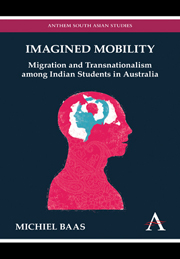Book contents
- Frontmatter
- Contents
- List of Illustrations
- List of Abbreviations and Acronyms
- Acknowledgements
- Chapter 1 Departure – Migration, Transnationalism and What Lies In-Between
- Chapter 2 First Semester – Of Leaving and Arriving: From and to a Culture of Migration
- Chapter 3 Second Semester – Some History Lessons as well as Learning the Hard Way
- Chapter 4 Summer School – A History of Students Going Overseas
- Chapter 5 Third Semester – Learning How to Work In-Between: Legal and Illegal Realms
- Chapter 6 Fourth Semester – Graduating as a Migrant
- Chapter 7 Arrival – Imagined Mobility
- Chapter 8 A New Departure – Curry Bashing and Alien Space Invaders
- Appendix Data, Dilemmas and Doing Fieldwork the Ethical Way
- Notes
- References
- Index
Chapter 5 - Third Semester – Learning How to Work In-Between: Legal and Illegal Realms
Published online by Cambridge University Press: 05 March 2012
- Frontmatter
- Contents
- List of Illustrations
- List of Abbreviations and Acronyms
- Acknowledgements
- Chapter 1 Departure – Migration, Transnationalism and What Lies In-Between
- Chapter 2 First Semester – Of Leaving and Arriving: From and to a Culture of Migration
- Chapter 3 Second Semester – Some History Lessons as well as Learning the Hard Way
- Chapter 4 Summer School – A History of Students Going Overseas
- Chapter 5 Third Semester – Learning How to Work In-Between: Legal and Illegal Realms
- Chapter 6 Fourth Semester – Graduating as a Migrant
- Chapter 7 Arrival – Imagined Mobility
- Chapter 8 A New Departure – Curry Bashing and Alien Space Invaders
- Appendix Data, Dilemmas and Doing Fieldwork the Ethical Way
- Notes
- References
- Index
Summary
The Hyphen In-Between Student-Migrant
Now that we have arrived in the third semester, the group of students we will focus on is comprised of people who have found their way and are used to living in Australia. This means that most of them have found part-time jobs and have formed their own social circle with whom they interact and hang out. In chapter one, the focus was typically on that very early phase of ‘arrival’ where everything was still new; chapter two focused on how newcomers and ‘outcomers’ meet and interact; this third ethnographic chapter will work with the assumption that for most Indian students these things are now a ‘given’. They know what they can expect, what is out there, and what they have to do in order to survive from day to day. They are no longer new arrivals, and no longer simply newcomers. Yet, at the same time, they certainly have not arrived in the sense of having achieved all they came for. And for the Indian community, organized in associations falling under the umbrella of the FIAV, it remains uncertain if this is a group of people which will stay or not. This confirms their place as a group which falls in-between all sorts of categorizations that feature in more traditional studies of overseas students or migrants.
- Type
- Chapter
- Information
- Imagined MobilityMigration and Transnationalism among Indian Students in Australia, pp. 105 - 136Publisher: Anthem PressPrint publication year: 2010



